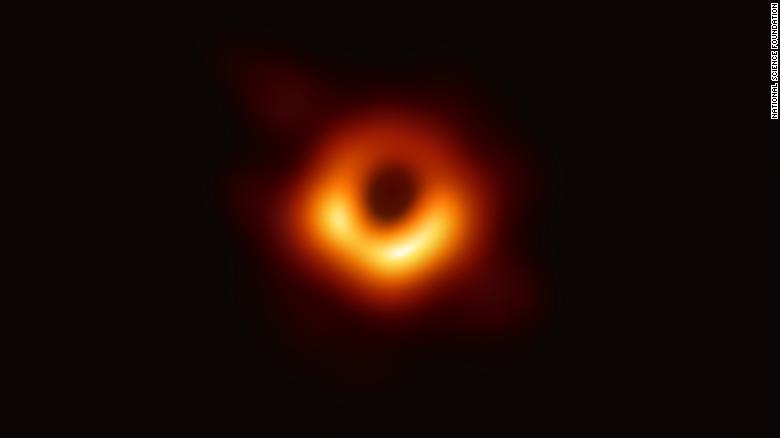

One solar mass is equivalent to the mass of our Sun, approximately 2x10^30 kilograms. Substantially more massive than Sagittarius A*, which contains 4 million solar masses, M87* contains 6.5 billion solar masses. One of the largest known supermassive black holes, M87* is located at the center of the gargantuan elliptical galaxy Messier 87, or M87, 53 million light-years (318 quintillion miles) away. The second target was the supermassive black hole M87*.

Image credits: NASA and the Hubble Heritage Team (STScI/AURA) | + Expand image
This image from NASA's Hubble Space Telescope shows a jet of subatomic particles streaming from the center of M87*. Nevertheless, because of the black hole’s local interest and relatively large size, the EHT team chose Sagittarius A* as one of its two targets. But its location in the same galaxy as Earth meant the team would have to look through “pollution” caused by stars and dust to image it, meaning there would be more data to filter out when processing the image. (An asterisk is the astronomical standard for denoting a black hole.) Though not the only black hole in our galaxy, it is the black hole that appears largest from Earth. The closest supermassive black hole to Earth, Sagittarius A*, interested the team because it is in our galactic backyard – at the center of our Milky Way galaxy, 26,000 light-years (156 quadrillion miles) away. To test VLBI for imaging a black hole and a number of computer algorithms for sorting and synchronizing data, the Event Horizon Telescope team decided on two targets, each offering unique challenges. Rezzolla ( Goethe University Frankfurt)/ Black Hole Cam/ EHT Collaboration | Watch on YouTube This video shows the global network of radio telescopes in the EHT array that performed observations of the black hole in the galaxy M87. This technique has been used to track spacecraft and to image distant cosmic radio sources, such as quasars. In some cases, the smaller telescopes are also an array of multiple telescopes. VLBI works by creating an array of smaller telescopes that can be synchronized to focus on the same object at the same time and act as a giant virtual telescope. That’s why the VLBI technique was essential to capturing the black hole image. To see details in objects that are far away and appear small and dim from Earth, we need to gather as much light as possible with very high resolution, so we need to use a telescope with a large aperture. The larger the diameter, or aperture, of the telescope, the greater its ability to gather more light and the higher its resolution (or ability to image fine details). Telescopes of all types are used to see distant objects. They set out to capture an image of a black hole by improving upon a technique that allows for the imaging of far-away objects, known as Very Long Baseline Interferometry, or VLBI.

A team formed to take on the challenge, creating a network of telescopes known as the Event Horizon Telescope, or the EHT. Though scientists had theorized they could image black holes by capturing their silhouettes against their glowing surroundings, the ability to image an object so distant still eluded them. Learning about these mysterious structures can help students understand gravity and the dynamic nature of our universe, all while sharpening their math skills. Working for well over a decade to achieve the feat, the team improved upon an existing radio astronomy technique for high-resolution imaging and used it to detect the silhouette of a black hole – outlined by the glowing gas that surrounds its event horizon, the precipice beyond which light cannot escape. For scientists, the challenge was how, from thousands or even millions of light-years away, to capture an image of the hot, glowing gas falling into a black hole.Īn ambitious team of international astronomers and computer scientists has managed to accomplish both. In the popular imagination, it was thought that capturing an image of a black hole was impossible because an image of something from which no light can escape would appear completely black. Find out how scientists created a virtual telescope as large as Earth itself to capture the first image of a black hole's silhouette.Īccomplishing what was previously thought to be impossible, a team of international astronomers has captured an image of a black hole’s silhouette.Įvidence of the existence of black holes – mysterious places in space where nothing, not even light, can escape – has existed for quite some time, and astronomers have long observed the effects on the surroundings of these phenomena.


 0 kommentar(er)
0 kommentar(er)
